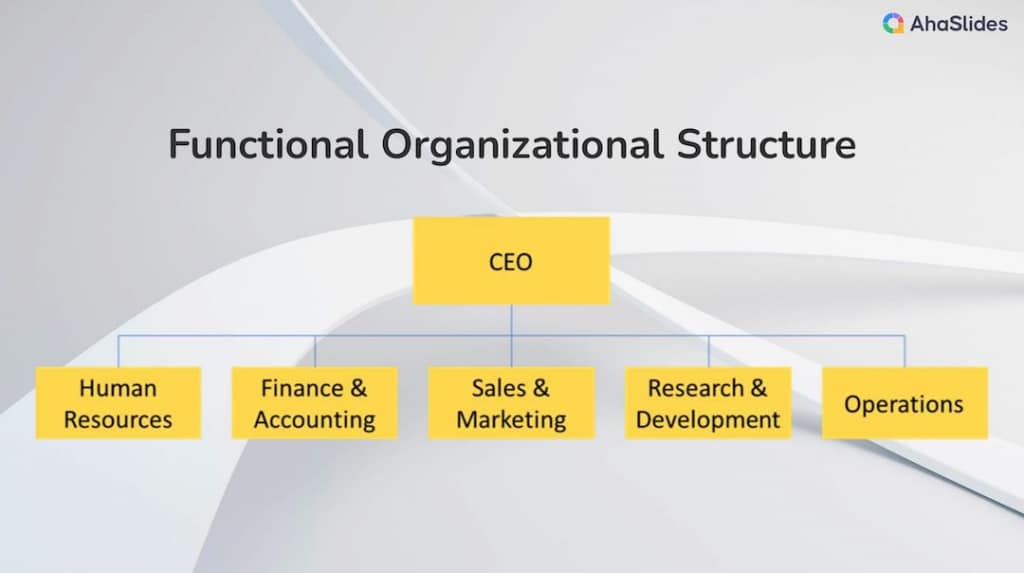![]() Shin kun taɓa mamakin yadda manyan kamfanoni ke tsara kansu a cikin duk sassan motsi?
Shin kun taɓa mamakin yadda manyan kamfanoni ke tsara kansu a cikin duk sassan motsi?
![]() Yayin da wasu kasuwancin ke aiki azaman rukunin haɗin gwiwa, da yawa suna kafa sassa daban-daban dangane da aiki. Wannan shi ake kira a
Yayin da wasu kasuwancin ke aiki azaman rukunin haɗin gwiwa, da yawa suna kafa sassa daban-daban dangane da aiki. Wannan shi ake kira a ![]() tsarin tsari na aiki.
tsarin tsari na aiki.
![]() Ko tallace-tallace ne, kuɗi, ayyuka, ko IT, ƙungiyoyin ɓangarori masu aiki bisa ga ƙwarewa.
Ko tallace-tallace ne, kuɗi, ayyuka, ko IT, ƙungiyoyin ɓangarori masu aiki bisa ga ƙwarewa.
![]() A zahiri, wannan rabuwar ayyuka da alama a bayyane yake - amma ta yaya gaske yake tasiri haɗin gwiwa, yanke shawara, da kasuwancin gaba ɗaya?
A zahiri, wannan rabuwar ayyuka da alama a bayyane yake - amma ta yaya gaske yake tasiri haɗin gwiwa, yanke shawara, da kasuwancin gaba ɗaya?
![]() A cikin wannan sakon, za mu duba ƙarƙashin murfin samfurin aiki da fa'idodinsa. Nutse kai tsaye!
A cikin wannan sakon, za mu duba ƙarƙashin murfin samfurin aiki da fa'idodinsa. Nutse kai tsaye!
 Table of Content
Table of Content
 Menene Tsarin Ƙungiya mai Aiki?
Menene Tsarin Ƙungiya mai Aiki? Amfanin Tsarin Ƙungiya mai Aiki
Amfanin Tsarin Ƙungiya mai Aiki Lalacewar Tsarin Ƙungiya mai Aiki
Lalacewar Tsarin Ƙungiya mai Aiki Cire Kalubalen Tsarin Ƙungiya mai Aiki
Cire Kalubalen Tsarin Ƙungiya mai Aiki Yaushe Tsarin Aiki Ya Dace?
Yaushe Tsarin Aiki Ya Dace? Misalai na Tsarin Ƙungiya mai Aiki
Misalai na Tsarin Ƙungiya mai Aiki Maɓallin Takeaways
Maɓallin Takeaways Tambayoyin da
Tambayoyin da
 Ƙarin Nasihu tare da AhaSlides
Ƙarin Nasihu tare da AhaSlides

 Neman Karin Nishaɗi Yayin Taro?
Neman Karin Nishaɗi Yayin Taro?
![]() Tara membobin ƙungiyar ku ta hanyar tambayoyi masu daɗi akan AhaSlides. Yi rajista don ɗaukar tambayoyin kyauta daga ɗakin karatu na samfurin AhaSlides!
Tara membobin ƙungiyar ku ta hanyar tambayoyi masu daɗi akan AhaSlides. Yi rajista don ɗaukar tambayoyin kyauta daga ɗakin karatu na samfurin AhaSlides!
 Menene Tsarin Ƙungiya mai Aiki?
Menene Tsarin Ƙungiya mai Aiki?

 Menene tsarin kungiya mai aiki?
Menene tsarin kungiya mai aiki?![]() Kamfanoni da yawa suna zaɓar su tsara kansu cikin sassa daban-daban bisa la'akari da nau'ikan ayyuka ko ayyukan da mutane suke yi, suna rarraba aiki zuwa wasu ayyuka na musamman.
Kamfanoni da yawa suna zaɓar su tsara kansu cikin sassa daban-daban bisa la'akari da nau'ikan ayyuka ko ayyukan da mutane suke yi, suna rarraba aiki zuwa wasu ayyuka na musamman.
![]() Wannan ake kira samun "
Wannan ake kira samun "![]() tsarin tsari na aiki
tsarin tsari na aiki![]() "Maimakon a haɗa duk wanda ke aiki a kan aiki ɗaya tare, an haɗa mutane ta hanyar gama gari na aikinsu - abubuwa kamar tallace-tallace, kudi, ayyuka, sabis na abokin ciniki, da dai sauransu.
"Maimakon a haɗa duk wanda ke aiki a kan aiki ɗaya tare, an haɗa mutane ta hanyar gama gari na aikinsu - abubuwa kamar tallace-tallace, kudi, ayyuka, sabis na abokin ciniki, da dai sauransu.
![]() Don haka alal misali, duk wanda ya ƙirƙira tallace-tallace, gudanar da kamfen ɗin kafofin watsa labarun, ko tunanin sabbin ra'ayoyin samfur zai kasance a cikin sashen tallace-tallace. Duk masu lissafin da ke bin kuɗi, biyan kuɗi da kuma shigar da haraji za su kasance tare a cikin kuɗi. Injiniyoyin za su yi aiki tare da sauran injiniyoyi a cikin ayyuka.
Don haka alal misali, duk wanda ya ƙirƙira tallace-tallace, gudanar da kamfen ɗin kafofin watsa labarun, ko tunanin sabbin ra'ayoyin samfur zai kasance a cikin sashen tallace-tallace. Duk masu lissafin da ke bin kuɗi, biyan kuɗi da kuma shigar da haraji za su kasance tare a cikin kuɗi. Injiniyoyin za su yi aiki tare da sauran injiniyoyi a cikin ayyuka.
![]() Manufar ita ce ta hanyar haɗa kowa da kowa da ke da irin wannan ƙwarewar aiki tare, za su iya taimaka wa juna da kuma koyi daga gwanintar juna. Hakanan za'a iya daidaita abubuwa kamar hanyoyin kuɗi a duk faɗin sashen.
Manufar ita ce ta hanyar haɗa kowa da kowa da ke da irin wannan ƙwarewar aiki tare, za su iya taimaka wa juna da kuma koyi daga gwanintar juna. Hakanan za'a iya daidaita abubuwa kamar hanyoyin kuɗi a duk faɗin sashen.
![]() Wannan tsarin ya sa ya yi aiki sosai domin ƙwararrun ba dole ba ne su ci gaba da neman amsoshi a wajen sashinsu. Amma kuma yana iya yin wahala ga yankuna daban-daban don yin haɗin gwiwa da kyau akan manyan ayyuka waɗanda ke buƙatar ƙwarewa da yawa. Sadarwa tsakanin sassan ma na iya yin asara wani lokaci.
Wannan tsarin ya sa ya yi aiki sosai domin ƙwararrun ba dole ba ne su ci gaba da neman amsoshi a wajen sashinsu. Amma kuma yana iya yin wahala ga yankuna daban-daban don yin haɗin gwiwa da kyau akan manyan ayyuka waɗanda ke buƙatar ƙwarewa da yawa. Sadarwa tsakanin sassan ma na iya yin asara wani lokaci.
![]() Gabaɗaya, tsarin aiki yana da kyau ga kamfanoni da aka kafa inda aka saita matakai, amma kamfanoni suna buƙatar nemo hanyoyin da za su haɗu da mutane tare da ma'aikatun don gujewa aiki a cikin nasu.
Gabaɗaya, tsarin aiki yana da kyau ga kamfanoni da aka kafa inda aka saita matakai, amma kamfanoni suna buƙatar nemo hanyoyin da za su haɗu da mutane tare da ma'aikatun don gujewa aiki a cikin nasu. ![]() silos
silos![]() yi yawa.
yi yawa.
 Amfanin Tsarin Ƙungiya mai Aiki
Amfanin Tsarin Ƙungiya mai Aiki

![]() An bincika mahimman fa'idodin tsarin ƙungiyoyi masu aiki a ƙasa:
An bincika mahimman fa'idodin tsarin ƙungiyoyi masu aiki a ƙasa:
 Ƙwarewar aiki - Mutane suna samun ƙwarewa a cikin takamaiman aikinsu ta hanyar mai da hankali kan waɗannan ayyuka kawai. Wannan yana haifar da haɓaka yawan aiki.
Ƙwarewar aiki - Mutane suna samun ƙwarewa a cikin takamaiman aikinsu ta hanyar mai da hankali kan waɗannan ayyuka kawai. Wannan yana haifar da haɓaka yawan aiki. Ƙaddamar da gwaninta - Irin wannan ƙwarewa an haɗa shi tare a cikin kowane sashe. Ma'aikata za su iya koya daga juna kuma su tallafa wa juna.
Ƙaddamar da gwaninta - Irin wannan ƙwarewa an haɗa shi tare a cikin kowane sashe. Ma'aikata za su iya koya daga juna kuma su tallafa wa juna. Daidaita ayyuka - Hanyoyi gama gari na aiki za a iya haɓaka da kuma rubuta su a cikin kowane aiki don daidaito.
Daidaita ayyuka - Hanyoyi gama gari na aiki za a iya haɓaka da kuma rubuta su a cikin kowane aiki don daidaito. Bayyanar layukan bayar da rahoto - A bayyane yake waɗanda ma'aikata ke ba da rahoto bisa ga rawar da suke takawa, ba tare da rahoton matrix ga manajoji da yawa ba. Wannan yana daidaita yanke shawara.
Bayyanar layukan bayar da rahoto - A bayyane yake waɗanda ma'aikata ke ba da rahoto bisa ga rawar da suke takawa, ba tare da rahoton matrix ga manajoji da yawa ba. Wannan yana daidaita yanke shawara. Rarraba albarkatu masu sassauƙa - Ma'aikata da babban jari za a iya sauya su cikin sauƙi a cikin sassa dangane da canza fifiko da nauyin aiki.
Rarraba albarkatu masu sassauƙa - Ma'aikata da babban jari za a iya sauya su cikin sauƙi a cikin sassa dangane da canza fifiko da nauyin aiki. Tattalin Arzikin Ma'auni - Ana iya raba albarkatu kamar kayan aiki da ma'aikata a cikin kowane sashe, rage farashin kowace naúrar fitarwa.
Tattalin Arzikin Ma'auni - Ana iya raba albarkatu kamar kayan aiki da ma'aikata a cikin kowane sashe, rage farashin kowace naúrar fitarwa. Sauƙaƙen aikin sa ido - Ma'auni na sashen na iya zama daɗaɗawa ga maƙasudai da sakamako tunda ayyuka sun bambanta.
Sauƙaƙen aikin sa ido - Ma'auni na sashen na iya zama daɗaɗawa ga maƙasudai da sakamako tunda ayyuka sun bambanta. Damar haɓaka sana'a - Ma'aikata na iya haɓaka ƙwarewarsu da sana'o'insu ta hanyar motsawa tsakanin matsayi a cikin keɓaɓɓen filin su.
Damar haɓaka sana'a - Ma'aikata na iya haɓaka ƙwarewarsu da sana'o'insu ta hanyar motsawa tsakanin matsayi a cikin keɓaɓɓen filin su. Sauƙaƙe Gudanarwa - Kowane shugaban sashe yana da iko akan sashe guda ɗaya, yana mai da gudanarwa ƙasa da rikitarwa.
Sauƙaƙe Gudanarwa - Kowane shugaban sashe yana da iko akan sashe guda ɗaya, yana mai da gudanarwa ƙasa da rikitarwa.
![]() Don haka a taƙaice, tsarin aiki yana haɓaka ƙwarewa, haɓaka ƙwarewa, da ingantaccen aiki a cikin ayyukan mutum ɗaya.
Don haka a taƙaice, tsarin aiki yana haɓaka ƙwarewa, haɓaka ƙwarewa, da ingantaccen aiki a cikin ayyukan mutum ɗaya.
 Lalacewar Tsarin Ƙungiya mai Aiki
Lalacewar Tsarin Ƙungiya mai Aiki

![]() A gefe guda na tsabar kudin, tsarin ƙungiya mai aiki ba shi da cikakken aibi. Kamfanoni yakamata suyi la'akari da waɗannan koma baya masu yuwuwa:
A gefe guda na tsabar kudin, tsarin ƙungiya mai aiki ba shi da cikakken aibi. Kamfanoni yakamata suyi la'akari da waɗannan koma baya masu yuwuwa:
 Halayen Silo - Sassan na iya mai da hankali kan burin kansu kawai maimakon burin ƙungiyar gaba ɗaya. Wannan yana hana haɗin gwiwa.
Halayen Silo - Sassan na iya mai da hankali kan burin kansu kawai maimakon burin ƙungiyar gaba ɗaya. Wannan yana hana haɗin gwiwa. Kwafi na ƙoƙarin - Ana iya yin ayyuka iri ɗaya akai-akai a sassa daban-daban maimakon daidaitawa cikin ayyuka.
Kwafi na ƙoƙarin - Ana iya yin ayyuka iri ɗaya akai-akai a sassa daban-daban maimakon daidaitawa cikin ayyuka. Sannun yanke shawara - Batutuwan da suka yanke sassan sassan suna ɗaukar lokaci mai tsawo don warwarewa kamar yadda suke buƙatar daidaitawa tsakanin silos.
Sannun yanke shawara - Batutuwan da suka yanke sassan sassan suna ɗaukar lokaci mai tsawo don warwarewa kamar yadda suke buƙatar daidaitawa tsakanin silos. Mummunan sabis na abokin ciniki - Abokan ciniki da ke hulɗa tare da sassa da yawa na iya karɓar ƙwarewar da ba ta dace ba ko rarrabuwa.
Mummunan sabis na abokin ciniki - Abokan ciniki da ke hulɗa tare da sassa da yawa na iya karɓar ƙwarewar da ba ta dace ba ko rarrabuwa. Matsaloli masu rikitarwa - Ayyukan da ke buƙatar haɗin kai tsakanin ayyuka na iya zama ruɗewa, rashin inganci, da takaici.
Matsaloli masu rikitarwa - Ayyukan da ke buƙatar haɗin kai tsakanin ayyuka na iya zama ruɗewa, rashin inganci, da takaici. Rashin sassauƙa don canzawa - Yana da wahala a matsawa da daidaita albarkatu cikin sauri lokacin da kasuwa ke buƙatar canji ko sabbin damammaki ya taso.
Rashin sassauƙa don canzawa - Yana da wahala a matsawa da daidaita albarkatu cikin sauri lokacin da kasuwa ke buƙatar canji ko sabbin damammaki ya taso. Wahalhalun da za a iya tantance ɓangarorin ciniki - Za a iya yin watsi da girman tasirin yanke shawara na aiki ba tare da la'akari da dogaro da juna ba.
Wahalhalun da za a iya tantance ɓangarorin ciniki - Za a iya yin watsi da girman tasirin yanke shawara na aiki ba tare da la'akari da dogaro da juna ba. Dogara ga masu kulawa - Ma'aikata sun dogara kacokan ga shugaban sashensu maimakon haɓaka hangen nesa mai girma.
Dogara ga masu kulawa - Ma'aikata sun dogara kacokan ga shugaban sashensu maimakon haɓaka hangen nesa mai girma. Ƙirƙirar ƙira - Sabbin ra'ayoyi masu buƙatar shigarwa daga wurare daban-daban suna da wahalar samun tallafi.
Ƙirƙirar ƙira - Sabbin ra'ayoyi masu buƙatar shigarwa daga wurare daban-daban suna da wahalar samun tallafi.
![]() Silos na aiki, jinkirin yanke shawara, da rashin haɗin gwiwa na iya lalata inganci da sassauci ga ƙungiyar da ke da wannan tsarin.
Silos na aiki, jinkirin yanke shawara, da rashin haɗin gwiwa na iya lalata inganci da sassauci ga ƙungiyar da ke da wannan tsarin.
 Cire Kalubalen Tsarin Ƙungiya mai Aiki
Cire Kalubalen Tsarin Ƙungiya mai Aiki
![]() Zai iya zama da wahala ga ƙungiyoyin aiki daban-daban kamar tallace-tallace, tallace-tallace, da tallafi don haɗawa idan koyaushe suna cikin sasanninta. Amma ware a zahiri yana da wahala a yi abubuwa. Ga wasu ra'ayoyin don shawo kan ƙalubalen:
Zai iya zama da wahala ga ƙungiyoyin aiki daban-daban kamar tallace-tallace, tallace-tallace, da tallafi don haɗawa idan koyaushe suna cikin sasanninta. Amma ware a zahiri yana da wahala a yi abubuwa. Ga wasu ra'ayoyin don shawo kan ƙalubalen:
![]() Yi ayyuka tare da mutane daga yankuna daban-daban. Wannan yana gabatar da kowa kuma ya sa su taimaki juna.
Yi ayyuka tare da mutane daga yankuna daban-daban. Wannan yana gabatar da kowa kuma ya sa su taimaki juna.
![]() Zabi mutane don taimakawa ƙungiyoyin haɗin gwiwa. Nada samfur / manajojin abokin ciniki, za su tabbatar da cewa kowa ya raba sabuntawa kuma ya warware batutuwa tare.
Zabi mutane don taimakawa ƙungiyoyin haɗin gwiwa. Nada samfur / manajojin abokin ciniki, za su tabbatar da cewa kowa ya raba sabuntawa kuma ya warware batutuwa tare.
![]() Mayar da hankali kan burin da aka raba, maimakon kowane yanki ya yi nasa abin da ya dace, daidaita mafarkan manyan kamfanoni duk suna tallafawa.
Mayar da hankali kan burin da aka raba, maimakon kowane yanki ya yi nasa abin da ya dace, daidaita mafarkan manyan kamfanoni duk suna tallafawa.
![]() Haɓaka kwafin ayyuka kamar HR ko IT don haka ƙungiya ɗaya ta yi hidima ga duk aikin rarrabuwa.
Haɓaka kwafin ayyuka kamar HR ko IT don haka ƙungiya ɗaya ta yi hidima ga duk aikin rarrabuwa.
![]() Saita tarurruka inda yankunan ke sabunta juna a taƙaice kan abin da ke faruwa. Matsaloli a cikin jiki.
Saita tarurruka inda yankunan ke sabunta juna a taƙaice kan abin da ke faruwa. Matsaloli a cikin jiki.

![]() Saka hannun jari a kayan aikin haɗin gwiwa - fasaha kamar intranets, docs/ sharing file, ko aikace-aikacen sarrafa ayyuka na iya sauƙaƙe daidaitawa.
Saka hannun jari a kayan aikin haɗin gwiwa - fasaha kamar intranets, docs/ sharing file, ko aikace-aikacen sarrafa ayyuka na iya sauƙaƙe daidaitawa.
![]() Haɓaka jujjuyawar sassauƙa. Bari ma'aikata su gwada wasu ayyuka a wani wuri na ɗan lokaci don fahimtar juna da haɓaka hangen nesa daban.
Haɓaka jujjuyawar sassauƙa. Bari ma'aikata su gwada wasu ayyuka a wani wuri na ɗan lokaci don fahimtar juna da haɓaka hangen nesa daban.
![]() Bibiyar aikin haɗin gwiwa kuma. Kula da yadda mutane ke samun jituwa da kuma KPI na ƙungiyar gaba ɗaya, ba kawai nasarorin mutum ɗaya ba. Ba wa shugabanni abubuwan ƙarfafawa don mai da hankali kan haɗin kai na ƙungiya, ba kawai KPI masu aiki ba.
Bibiyar aikin haɗin gwiwa kuma. Kula da yadda mutane ke samun jituwa da kuma KPI na ƙungiyar gaba ɗaya, ba kawai nasarorin mutum ɗaya ba. Ba wa shugabanni abubuwan ƙarfafawa don mai da hankali kan haɗin kai na ƙungiya, ba kawai KPI masu aiki ba.
![]() A ƙarshe, ƙarfafa hulɗar zamantakewa don kowane sashe ya zama mafi dacewa da kusanci juna don taimako. Neman hanyoyin ayyuka don hulɗa da aiki a matsayin haɗin kai gaba ɗaya zai taimaka wajen rushe silos.
A ƙarshe, ƙarfafa hulɗar zamantakewa don kowane sashe ya zama mafi dacewa da kusanci juna don taimako. Neman hanyoyin ayyuka don hulɗa da aiki a matsayin haɗin kai gaba ɗaya zai taimaka wajen rushe silos.
 Fasa kankara tare da AhaSlides
Fasa kankara tare da AhaSlides
![]() Taimaka wa kowane sashe haɗi da haɗi tare da hulɗar AhaSlides. Mahimmanci ga zaman haɗin gwiwar kamfanoni!🤝
Taimaka wa kowane sashe haɗi da haɗi tare da hulɗar AhaSlides. Mahimmanci ga zaman haɗin gwiwar kamfanoni!🤝

 Yaushe Tsarin Aiki Ya Dace?
Yaushe Tsarin Aiki Ya Dace?

![]() Bincika lissafin don ganin ko ƙungiyar ku ta dace don samar da wannan tsarin:
Bincika lissafin don ganin ko ƙungiyar ku ta dace don samar da wannan tsarin:
![]() ☐ Kafaffen kamfanoni tare da daidaitattun ayyuka - Ga manyan kamfanoni waɗanda ainihin tsarin tafiyar da ayyukansu ke da ma'ana, ƙwarewa a cikin ayyuka na iya haɓaka inganci.
☐ Kafaffen kamfanoni tare da daidaitattun ayyuka - Ga manyan kamfanoni waɗanda ainihin tsarin tafiyar da ayyukansu ke da ma'ana, ƙwarewa a cikin ayyuka na iya haɓaka inganci.
![]() ☐ Tsayayyen yanayin kasuwanci - Idan kasuwa da buƙatun abokin ciniki suna da ɗan tsinkaya, ƙungiyoyin aiki za su iya mai da hankali kan inganta wuraren ƙwararrun su ba tare da buƙatar haɗin gwiwar sashe cikin sauri ba.
☐ Tsayayyen yanayin kasuwanci - Idan kasuwa da buƙatun abokin ciniki suna da ɗan tsinkaya, ƙungiyoyin aiki za su iya mai da hankali kan inganta wuraren ƙwararrun su ba tare da buƙatar haɗin gwiwar sashe cikin sauri ba.
![]() ☐ Ayyukan da ke buƙatar ƙwarewar sadaukarwa - Wasu ayyuka kamar aikin injiniya, lissafin kuɗi, ko aikin shari'a sun dogara da zurfin ƙwarewar fasaha kuma sun dace da tsarin aiki.
☐ Ayyukan da ke buƙatar ƙwarewar sadaukarwa - Wasu ayyuka kamar aikin injiniya, lissafin kuɗi, ko aikin shari'a sun dogara da zurfin ƙwarewar fasaha kuma sun dace da tsarin aiki.
![]() ☐ Bada fifikon aiwatar da aiwatarwa - Tsarin aiki yana da inganci sosai lokacin da ƙungiyar ta ba da fifikon samarwa ko isar da samfur ko sabis; Ware matakai na musamman tsakanin ayyuka na iya daidaita aiwatar da aiwatarwa.
☐ Bada fifikon aiwatar da aiwatarwa - Tsarin aiki yana da inganci sosai lokacin da ƙungiyar ta ba da fifikon samarwa ko isar da samfur ko sabis; Ware matakai na musamman tsakanin ayyuka na iya daidaita aiwatar da aiwatarwa.
![]() ☐ Manya-manyan ƙungiyoyi masu ma'auni - Manya-manyan kamfanoni masu dubban ma'aikata na iya tsarawa zuwa ayyuka kawai don sarrafa sarƙaƙƙiya a cikin sassan kasuwanci da yawa.
☐ Manya-manyan ƙungiyoyi masu ma'auni - Manya-manyan kamfanoni masu dubban ma'aikata na iya tsarawa zuwa ayyuka kawai don sarrafa sarƙaƙƙiya a cikin sassan kasuwanci da yawa.
![]() ☐ Batun rabon albarkatu ya fi girma - Ga masana'antu masu fa'ida, tsarin da ke sauƙaƙe daidaitaccen rabon kayan aiki na musamman yana aiki da kyau.
☐ Batun rabon albarkatu ya fi girma - Ga masana'antu masu fa'ida, tsarin da ke sauƙaƙe daidaitaccen rabon kayan aiki na musamman yana aiki da kyau.
![]() ☐ Al'adun hukuma na gargajiya - Wasu kafaffun kamfanoni sun fi son saiti na sashe sosai don sarrafawa da kulawa.
☐ Al'adun hukuma na gargajiya - Wasu kafaffun kamfanoni sun fi son saiti na sashe sosai don sarrafawa da kulawa.
 Misalai na Tsarin Ƙungiya mai Aiki
Misalai na Tsarin Ƙungiya mai Aiki

 Misalin ƙungiya mai aiki.
Misalin ƙungiya mai aiki.![]() Kamfanin Fasaha:
Kamfanin Fasaha:
 Sashen tallatawa
Sashen tallatawa Sashen Injiniya
Sashen Injiniya Sashen ci gaban samfur
Sashen ci gaban samfur IT/Sashen Ayyuka
IT/Sashen Ayyuka Sashen tallace-tallace
Sashen tallace-tallace Sashen Tallafin Abokin Ciniki
Sashen Tallafin Abokin Ciniki
![]() Kamfanin Kera:
Kamfanin Kera:
 Sashen samarwa/Aiki
Sashen samarwa/Aiki Sashen Injiniya
Sashen Injiniya Sashen sayayya
Sashen sayayya Sashen Kula da inganci
Sashen Kula da inganci Sashen Dabaru/Rarraba
Sashen Dabaru/Rarraba Sashen tallace-tallace da tallace-tallace
Sashen tallace-tallace da tallace-tallace Sashen Kudi da Accounting
Sashen Kudi da Accounting
![]() Asibitin:
Asibitin:
 Sashen jinya
Sashen jinya Sashen Radiyo
Sashen Radiyo Sashen tiyata
Sashen tiyata Sashen Lab
Sashen Lab Sashen kantin magani
Sashen kantin magani Sashen Gudanarwa/Biyan Kuɗi
Sashen Gudanarwa/Biyan Kuɗi
![]() Kantin Kasuwanci:
Kantin Kasuwanci:
 Store ayyuka sashen
Store ayyuka sashen Sashen ciniki/Sayayya
Sashen ciniki/Sayayya Sashen tallatawa
Sashen tallatawa Sashen Kudi/Accounting
Sashen Kudi/Accounting HR sashen
HR sashen Sashen rigakafin hasara
Sashen rigakafin hasara Sashen IT
Sashen IT
![]() Jami'a:
Jami'a:
 Sassan ilimi daban-daban kamar Biology, Turanci, Tarihi, da makamantansu
Sassan ilimi daban-daban kamar Biology, Turanci, Tarihi, da makamantansu Sashen Harkokin Dalibai
Sashen Harkokin Dalibai Sashen kayan aiki
Sashen kayan aiki Sashen Bincike na Tallafawa
Sashen Bincike na Tallafawa Sashen wasannin motsa jiki
Sashen wasannin motsa jiki Sashen Kudi da Gudanarwa
Sashen Kudi da Gudanarwa
![]() Waɗannan wasu misalan ne na yadda kamfanoni a masana'antu daban-daban za su iya haɗa ayyuka na musamman da ayyuka zuwa sassa don samar da tsarin ƙungiya mai aiki.
Waɗannan wasu misalan ne na yadda kamfanoni a masana'antu daban-daban za su iya haɗa ayyuka na musamman da ayyuka zuwa sassa don samar da tsarin ƙungiya mai aiki.
 Sake mayar da martani muhimmin abu ne wanda ke haɓaka ingantaccen aiki a cikin ƙungiyoyi. Tara ra'ayoyin abokan aiki da tunani tare da shawarwarin 'Ba a san su ba' daga AhaSlides.
Sake mayar da martani muhimmin abu ne wanda ke haɓaka ingantaccen aiki a cikin ƙungiyoyi. Tara ra'ayoyin abokan aiki da tunani tare da shawarwarin 'Ba a san su ba' daga AhaSlides. Maɓallin Takeaways
Maɓallin Takeaways
![]() Yayin da rarraba aiki zuwa sassa na musamman yana da fa'idodinsa, yana da sauƙi don silo don ƙirƙirar tsakanin ƙungiyoyi. Don samun nasara da gaske, kamfanoni suna buƙatar haɗin gwiwa gwargwadon ƙwarewa kawai.
Yayin da rarraba aiki zuwa sassa na musamman yana da fa'idodinsa, yana da sauƙi don silo don ƙirƙirar tsakanin ƙungiyoyi. Don samun nasara da gaske, kamfanoni suna buƙatar haɗin gwiwa gwargwadon ƙwarewa kawai.
![]() A ƙarshen rana, duk muna cikin ƙungiya ɗaya. Ko kun ƙirƙiri samfura ko sadar da sabis na abokin ciniki, aikinku yana goyan bayan wasu da maƙasudin kamfanin gaba ɗaya.
A ƙarshen rana, duk muna cikin ƙungiya ɗaya. Ko kun ƙirƙiri samfura ko sadar da sabis na abokin ciniki, aikinku yana goyan bayan wasu da maƙasudin kamfanin gaba ɗaya.
💡 ![]() Dubi kuma:
Dubi kuma: ![]() The
The ![]() Nau'o'in Tsarin Ƙungiya 7
Nau'o'in Tsarin Ƙungiya 7 ![]() Kuna Bukatar Ku sani.
Kuna Bukatar Ku sani.
 Tambayoyin da
Tambayoyin da
![]() Menene tsarin ƙungiyoyin aiki guda 4?
Menene tsarin ƙungiyoyin aiki guda 4?
![]() Tsarukan ƙungiyoyi huɗu masu aiki sune Aiki, yanki, matrix, da tsarin cibiyar sadarwa.
Tsarukan ƙungiyoyi huɗu masu aiki sune Aiki, yanki, matrix, da tsarin cibiyar sadarwa.
![]() Me ake nufi da tsarin aiki?
Me ake nufi da tsarin aiki?
![]() Tsarin tsari na aiki yana nufin yadda kamfani ke rarraba ayyukansa da sassansa bisa ayyuka ko layukan aikin da aka yi yayin aiki.
Tsarin tsari na aiki yana nufin yadda kamfani ke rarraba ayyukansa da sassansa bisa ayyuka ko layukan aikin da aka yi yayin aiki.
![]() Shin McDonald's tsarin tsari ne mai aiki?
Shin McDonald's tsarin tsari ne mai aiki?
![]() McDonald's yana da tsarin ƙungiya na yanki inda kowane yanki ke hidima ga takamaiman wurin yanki kuma yana aiki kusan kansa tare da sassansa daban kamar tallace-tallace, tallace-tallace, kuɗi, doka, wadata, da makamantansu.
McDonald's yana da tsarin ƙungiya na yanki inda kowane yanki ke hidima ga takamaiman wurin yanki kuma yana aiki kusan kansa tare da sassansa daban kamar tallace-tallace, tallace-tallace, kuɗi, doka, wadata, da makamantansu.







